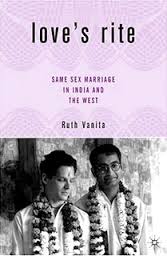 Love’s Rite: Same-Sex Marriage in India and the West
Love’s Rite: Same-Sex Marriage in India and the West
by Ruth Vanita
Palgrave Macmillan. 288 pages, $65.
IN LOVE’S RITE, Ruth Vanita takes us through a memory hole of Asian history to a world where the forgotten (sometimes suppressed) esoterica of same-sex couplings can be found. The country is India and the time is before British colonial rule. According to Vanita, South Asia had “no premodern history of persecuting people for same-sex relations. … Under colonial rule, what was a minor strain of homophobia in Indian traditions became the dominant ideology. The British introduced in India, as in most countries they colonized, a law criminalizing any type of sex other than penile-vaginal penetrative sex.”
Colonial influence helped so-called social reformers purge Indian premodern literature of its homoerotic elements and to heterosexualize Indian classics such as the Urdu Ghazal. But what the reformers couldn’t do was change the words of the Kamasutra, that nonjudgmental Indian erotic classic of the 4th century CE. The Kamasutra divides human beings into three types—men, women, and people of a third nature. The latter, the text explains, can be further divided into masculine- and feminine-appearing men who desire other men. Other ancient texts, including Sanskrit plays, Jain texts, and even Hindu medical writings, acknowledge this third category of human being with same-sex desire.
While British colonists couldn’t eradicate this rich iconography, they could help to change the way it was interpreted. The sanitization squads worked overtime to have these texts rendered less “embarrassing.” Writes Vanita: “Most Indians view the Kamasutra with a mixture of pride and embarrassment. Most Hindu translators insist that the Kamasutra catalogs varieties of sex only to warn the reader against them.”
Gay and lesbian stories in Hinduism’s sacred texts might be perceived by enlightened religionists as a potential springboard for cultural change. The problem, however, is that there are thousands of such sacred texts in Hinduism, so these gay and lesbian “links” may not be as significant or powerful as if they were concentrated in one sacred text, such as the Jewish and Christian Bible. The references are numerous enough, however, to support the idea of a longstanding tradition of same-sex marriage among Indians. Hindu fundamentalists, to be sure, insist that same-sex relations are contrary to Hindu tradition and blame the West for “exporting” homosexuality to their shores.
In India today, Hindu priests will sometimes perform same-sex wedding ceremonies despite the official position of Hinduism opposing them. On the other hand, families will sometimes go to great lengths to prevent such a wedding from taking place. Vanita cites cases in which families kidnapped a daughter who was living with a female partner. Occasionally an impending same-sex wedding will inspire violence from family members; at other times the distraught couple that wants to wed will commit suicide together. (Couple suicide is not unknown in Indian culture. It can occur among heterosexuals when one or both families disapprove of an impending union. Lovers will bind their hands together with cords or ribbons and jump from buildings or from boats into large bodies of water. These suicides hinge on the belief that in the afterlife the couple will be happily reunited.)
The Hindu priests who have married same-sex couples often report that the holy texts support such arrangements because marriage is about the uniting of two souls. Since the soul has no gender, marriages of same-sex or opposite-sex couples are essentially the same. Hindu religious texts also support this depolarization of the sexes. Writes Vanita:
Gods as well as humans may temporarily become female. Sometimes the change results from a curse or functions as a test, but sometimes it occurs purely for erotic purposes. In Valmiki’s ‘Ramayana,’ King Ila, while wandering in the forest, enters a grove where Shiva and Parvati are engaged in love play. Shiva turns into a female to please Parvati. Mirroring him, every other being in the forest turns female too. This suggests that satisfying love play includes both the heteroerotic and the homoerotic.
Among the many stories of intimate friendship, suicides pacts, elopements, and secret weddings with cross-dressing disguises, Vanita inserts a series of comparisons with the status of same-sex couples in Western culture. These diversions take the form of mini-chapters with titles like “The Will & Grace Syndrome,” “The Green Card Marriage,” and “Why Not Stay on the Down Low?” These detours make for abrupt transitions and give the book a choppiness that could easily have been avoid. This organizational problem aside, however, Love’s Rite succeeds in offering a rich glimpse into an aspect of Indian history and culture that has been systematically neglected and suppressed.
______________________________________________________________
Thom Nickels is the author of Out in History and Philadelphia Architecture. Check out www.Lincoln-in-louisville.com.





